Hey, remember that time Marvel responded to complaints about diversity and created books with people of color and women as the leads, and even hired women to write the books with the women characters? You know, forty-three years ago, back in 1972?
Honestly? Me neither. I was all of six then, and although I want to imagine otherwise, it looks like the comic book bug didn’t bite, infect, and rewrite my central nervous system with its own miswired genetic material until around 1974.
Nonetheless, it happened. As explained in Sean Howe’s Marvel Comics: The Untold Story (with no small amount of rueful head-shaking):
For added authenticity (or gimmickry, depending on one’s level of cynicism), each of the three new titles was to be written by a woman. Unfortunately, there was none presently writing for Marvel, so Thomas improvised. He drafted his wife, Jeanie, Hulk artist Herb Trimpe’s new wife, Linda Fite, and comic conventioneer Phil Seuling’s wife, Carole. [Stan] Lee came up with all three concepts the same day, and the titles spoke for themselves: Night Nurse, The Claws of the Cat, and Shanna the She-Devil. In the year of Helen Reddy’s “I Am Woman” and the launch of Ms. magazine, Marvel’s tales of candy stripers, cat-suited sexpots, and jungle queens could hardly be called revolutionary.
I adore Howe’s book, and while the skepticism here is probably appropriate, it did make me wonder. How hard would it be to write a paragraph casting many of Marvel’s recent moves in the same light? (For those playing at home, the answer is not hard at all.)
(More behind the jump because, of course, I do tend to go on, don’t I?)I know I’m not the only wide-eyed dreamer who wishes Marvel Unlimited could be something like a genuine resource for research—and maybe it can be, if your topic is the rise of titles for a character in the year of their movie’s releas—so I expect you’ll understand I was a little bummed to find no results for “Night Nurse” in either the title or character searches on the app. (I mean, c’mon, Marvel, a revised version of the character appears in Doctor Strange: The Oath, which is on the service, y’know, to say nothing of her other appearances in Brian Bendis’ Avengers.)
Fortunately, Marvel’s BOGO sale through Comixology fell on a quiet day at work, such that I could spend some time perusing all the titles available for sale…and this is how I ended up with digital copies of Astonishing Tales (Deathlok!), a few issues of Marvel Spotlight….and all four issues of Night Nurse. And despite my significant love and affection for Astonishing Tales (Deathlok!), I turned to Night Nurse first.
And here’s the thing: although it’s pretty easy to see why Night Nurse lasted only four issues, it’s not terrible.
It’s not great—in fact, I hesitate to even call it ‘good’—but the closest I can see to bad faith on the part of Marvel could be the complete exclusion of any superheroes, superpowers, or connections to the rest of the Marvel Universe (the way Marvel’s horror work like Man-Thing or Son of Satan did), and arguably the use of Win Mortimer as artist, as opposed to one of the many up & comers or established names at Marvel. And even on that last point: although at the age of 53, Mortimer may not have been the best choice to pencil a title about four modern women trying to navigate the chaos of the ’70s, he’d recently co-created Stanley and his Monster with Arnold Drake and drawn stuff like Swing With Scooter.
The art for Night Nurse was very much in the style of the romance comics at the time, where a single tear clusters under one eye like a glob of fallen thought balloon, the kind of thing you still see mocked on snarky birthday cards today. That style has a deliberately astringent quality, one that seems a compromise between the awareness that the work is being created for objectified women by objectifying men: the women still do a lot of their thinking while showering and undressing, but their art has all the sensuality of vegetarian bacon.
In any event, Mortimer’s dutiful complacent storytelling and Jean Thomas’s overstuffed scripts end up creating a book of remarkable torpor (which you can see the copywriter for the cover of the first issue—Roy Thomas, probably—do their best to counteract with a wild sowing of exclamation points and dangerously overheated hyperbole: “All The Glamour–The Heartache–The Throbbing Excitement–Of A Big-City Hospital!” and “Enter The World of of Danger, Drama, and Death!” As well as—and here’s the kiss of death if ever there was one—”Great first issue!,” which on the ’70s Marvel scale of hyperbole equates to “He’s fun, isn’t he?” or “She has nice hair!” or “It tastes fine!”).
From the first full page splash of Nurse Linda Carter—a name containing no small amount of ’70s superhero dissonance for those of us who also watched the Wonder Woman TV show—tearfully thinking, “I’ve got to choose—choose between the man I love—and becoming a nurse!” drawn by Mortimer in a way that makes Frank Springer look like Jim Steranko, the reader has a front-row seat to a neophyte writer (and her editor husband) struggling to solve the seemingly unsolvable: how to take the romance comic, one of the last bastions of the comic short story format, and make it a concept sturdy enough to support a multi-issue format.
As with a lot of bad carpentry, they choose to ignore the inherent structural flaws and decide on hammering on a bunch of extra planks. In the first issue alone, we get flashbacks to Linda studying to become a nurse, meeting her contentious roommates Christine Palmer and Georgia Jenkins, having all three eventually bond, to having Linda fall in love with a handsome patient…in the first ten pages, no less.
Additionally, Christine and Georgia each have their own burdens to overcome as nurses (a formerly well-off suburbanite, Christine wants to make her way in life without being supported by her father’s money; Georgia struggles to both transcend and redeem her inner city upbringing). And in case all of that wasn’t enough, the overheated summer is causing blackouts in Christine’s neighborhood, causing the residents to seethe with resentment at how the rich parts of town—and the hospital—remain unaffected.
Before you know it, there are counterculture types trying to bomb the hospital’s generator (one being Georgia’s brother, and the other being only in it for the money—Marvel’s view of the counterculture being arguably as fair-minded as Forrest Gump‘s), gun fights, mass hysteria, etc. Somewhere on the last page, Linda’s love interest bellows, “You’re either my wife, or a nurse—not both!”, and that’s that.
Like I said, a lot of planks, but they’re still supporting the sagging worldview of romance comics as channeled by Roy Thomas through his soon-to-be-ex-wife. A woman’s internal landscape is an essentially static one, and her desires passive: when caught between a vocation (for which her appreciation has been expressed in flat declarative statements) and the love of a man (which a priori is the most important thing in the world), the heroine can do nothing but tremble with conflict until that single glob of fallen thought balloon gathers under her eye.
Issue #2 is a little more focused, dealing with Christine’s somewhat significant father issues as she ends up wined and wooed by an older doctor who asks her to help cook his books and cover up his prescription abuse, but it also wedges in a hit & run mystery, a new romantic interest for Linda (hunky resident Dr. Tryon, whose resemblance to a Ken doll is pretty impressive), and all the drama one can wring out of the phrase “hastily called inquest.” But, again, although Mortimer dutifully jams every emotional beat onto the page—as with issue one, the average panel count per page rarely drops below seven—his representational drawing makes Don Heck look like Geoff Darrow.
Issue #3 brings in the mob to spruce things up, with a dead man thrown into the Emergency Room by two fleeing thugs, an underworld head being shot and then, once under Linda’s care, stalked by hitmen. And in another decent touch, Georgia has to decided whether to help Linda protect the underworld head, despite the fact that her own brother just got sentenced to ten-to-twenty in the state penitentiary.
Here, Mortimer’s work is a bit stronger—nothing like an issue filled with middle-aged men with mustaches for a middle-aged man with a mustache to cut loose on!—but, apart from a well-staged tussle over a silenced revolver (although I don’t think silencers work on revolvers, if I’m correctly remembering what I learned from the Junior Woodchucks Guide), Mortimer’s linework makes Vince Colletta look like Mike Kaluta.
Jean Thomas co-writes issue #4 with Linda Fite (according to Howe, the sole female scripter out of the trio with any previous writing experience) and it picks up with Christine again, after she’d run off at the end of issue #2, but instead of overheated hospital drama, this issue departs for the hoary moors of gothic romance shenanigans: abandoned mansion, handsome-but-surly charge, suspicious servants, mysterious accidents, ghostly lights flashing late at night by the cliffside, you know the drill.
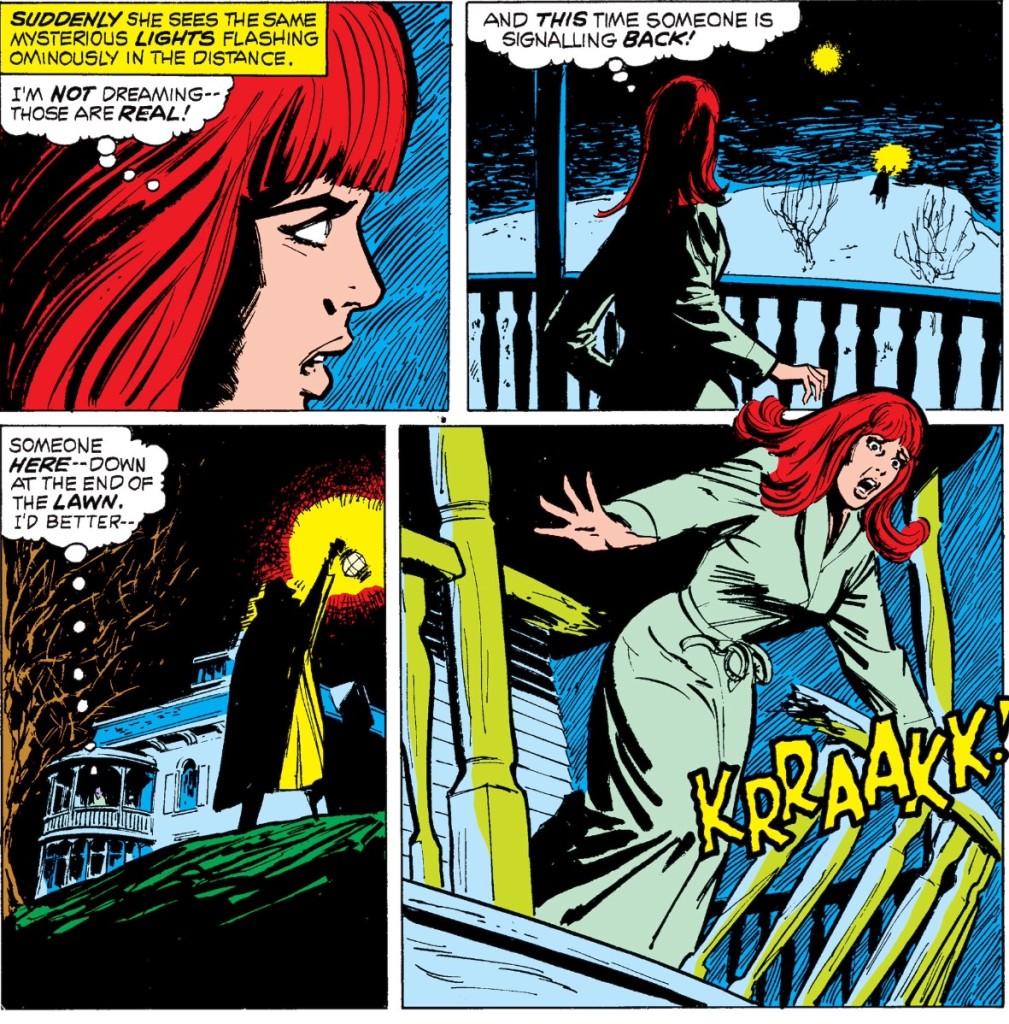 Mortimer’s work makes Dick Dillin look like Bernie Wrightson, but that’s not the worst of it: even with Linda, Georgia, and dreamy Dr. Tryon whittled out of the issue, the book is still an inert overstuffed lump. I think a lot of that is neophyte’s disease—Thomas and Fite can have a scene that advances the character’s relationship or a scene where some action happens, but they haven’t yet learned how to do both at the same time (to be fair, a central tenet of this kind of gothic romance is isolation, so the heroine being in danger when no one else is around is probably inescapable).
Mortimer’s work makes Dick Dillin look like Bernie Wrightson, but that’s not the worst of it: even with Linda, Georgia, and dreamy Dr. Tryon whittled out of the issue, the book is still an inert overstuffed lump. I think a lot of that is neophyte’s disease—Thomas and Fite can have a scene that advances the character’s relationship or a scene where some action happens, but they haven’t yet learned how to do both at the same time (to be fair, a central tenet of this kind of gothic romance is isolation, so the heroine being in danger when no one else is around is probably inescapable).
But a lot of it just boils down to the mistaken belief that men and women want something different from their stories. To the extent that’s true, I think it’s reasonable to assume the difference isn’t that woman are sitting around saying, “Boy, I sure would like a series of stories about a passive character thrust into action…but only if she’s entirely reactive and has no will or desire of her own!”
To lesser and greater degrees of success, Roy Thomas oversaw the transference of the Marvel heroic/antiheroic template onto sword & sorcery comics (Conan), the kung-fu craze (Shang-Chi and Iron Fist), blaxploitation (Luke Cage), and biker tattoos (Ghost Rider). But Night Nurse is a scalding failure because it’s obvious that never once does Thomas consider applying that template to the book’s women leads. Linda, Georgia, and Christine never get the opportunity to heroically save a world that misunderstands them, because it’s impossible for them to be misunderstood: women are the embodiment of that world. The only drama they can generate on their own is when they are forced to choose between two conflicting incarnations of the status quo, whether to be wife or nurse, daughter or worker. And once they’ve decided, they become inert, entirely reactive, with nothing to keep things moving but the melodrama of gangsters and riots and drug-smuggling dudes in wheelchairs.
The closest we get in the series to the kind of “save the world and be damned” Marvel template is in issue #2 when Christine can no longer bring herself to cover for the doctor she loves at his inquest…but by the time she does, she’s already watched the guy cheat his pharmaceutical records, steal hospital equipment, hit and run a parked car, operate while drunk, and kill someone on the operating table due to his inebriation.
That’s how heavily the deck has to be stacked by the Thomases to make sure the readers don’t think Christine’s stand is just a fickle betrayal, and it drains any feeling of heroism from her choice. Christine is just a patsy pushed beyond her limits.
So, yeah. Night Nurse ends up being both heroic attempt and a damnable failure, worth congratulating and condemning. And so I think I can honestly say to current day Marvel:
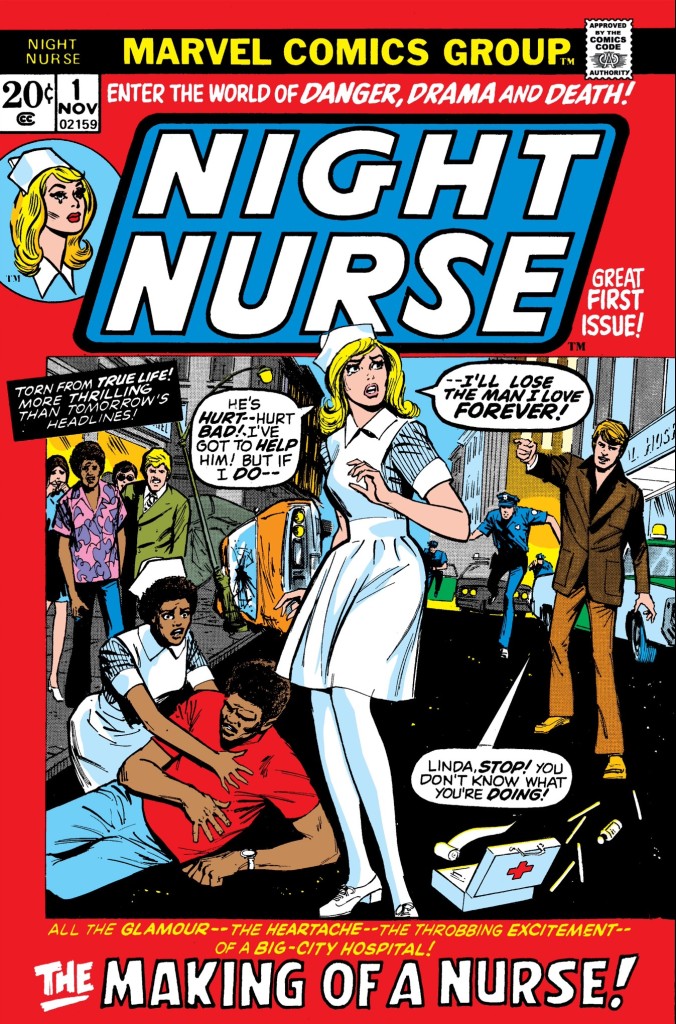
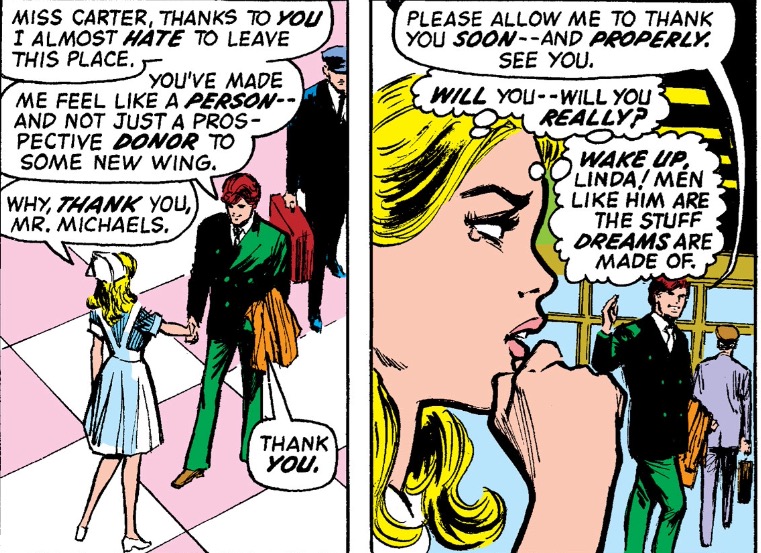
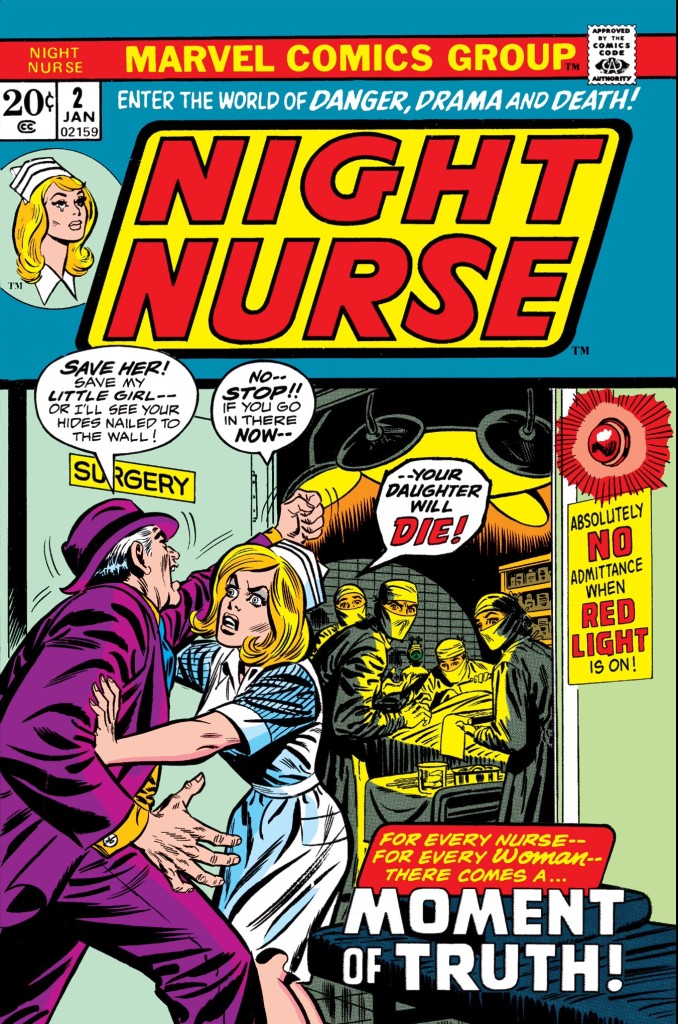
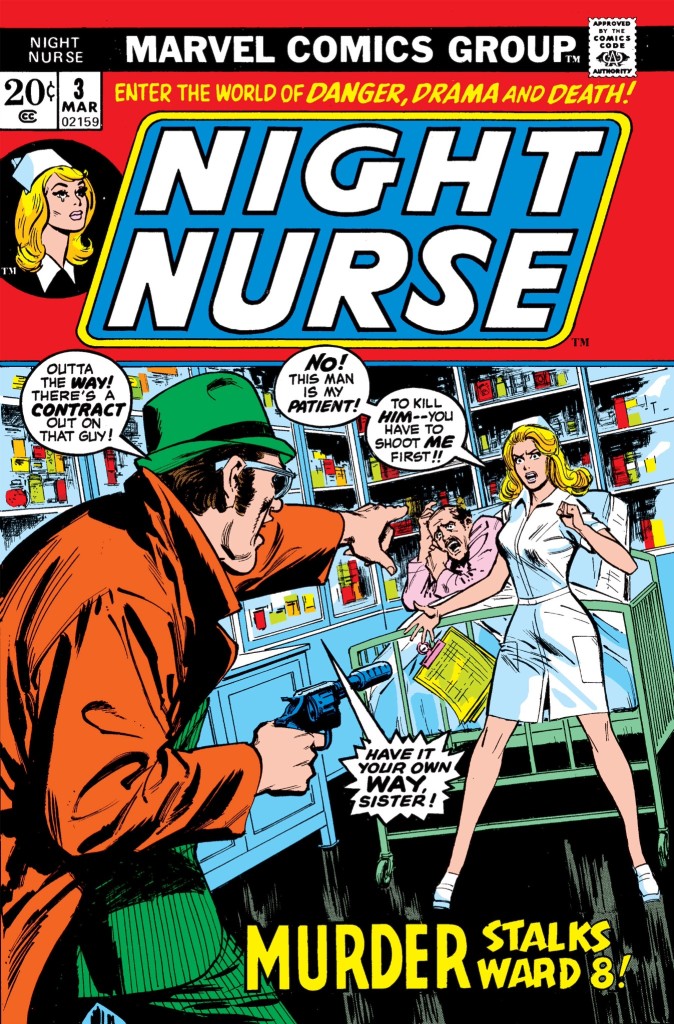
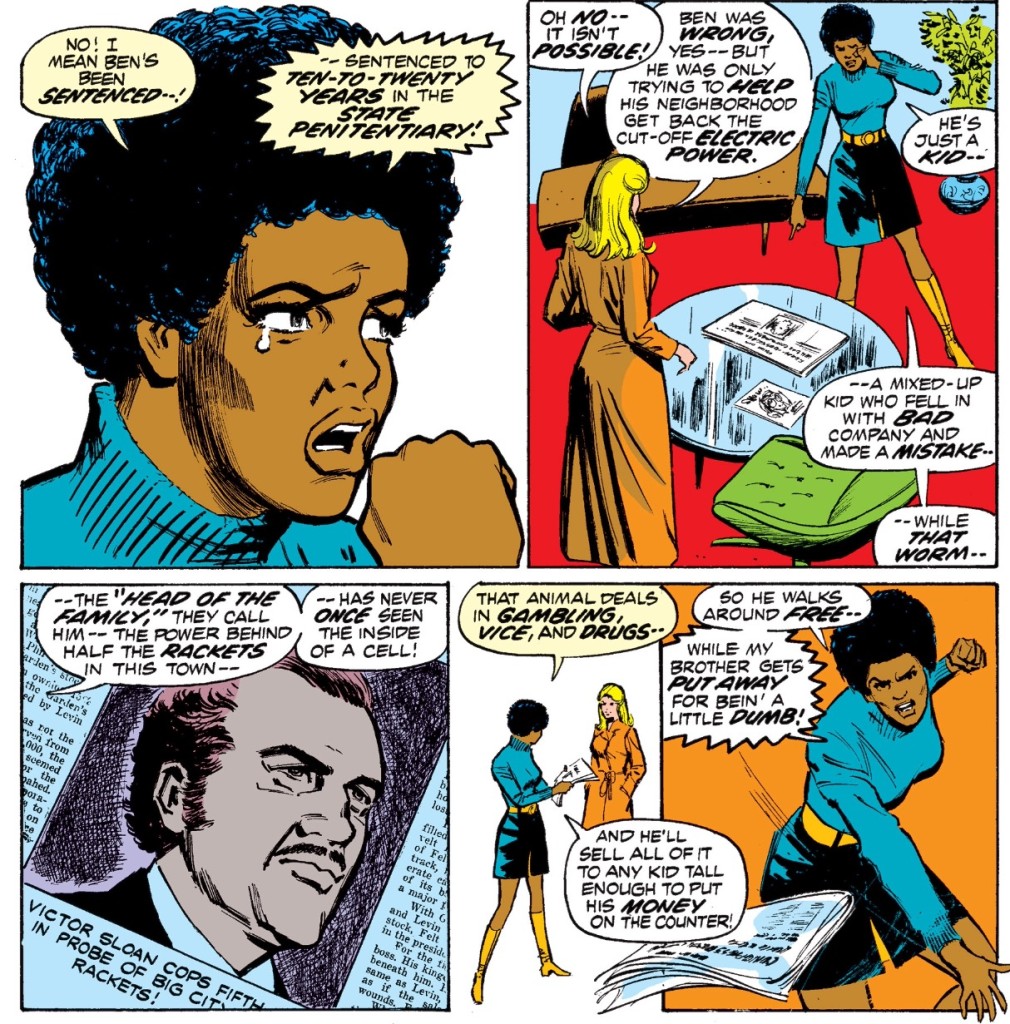
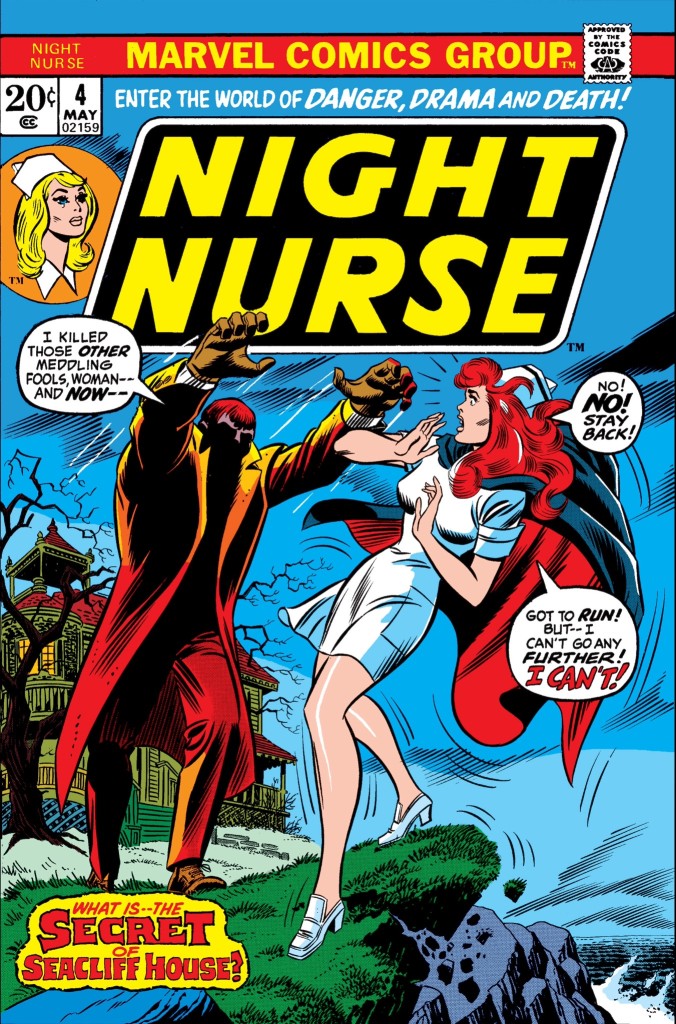
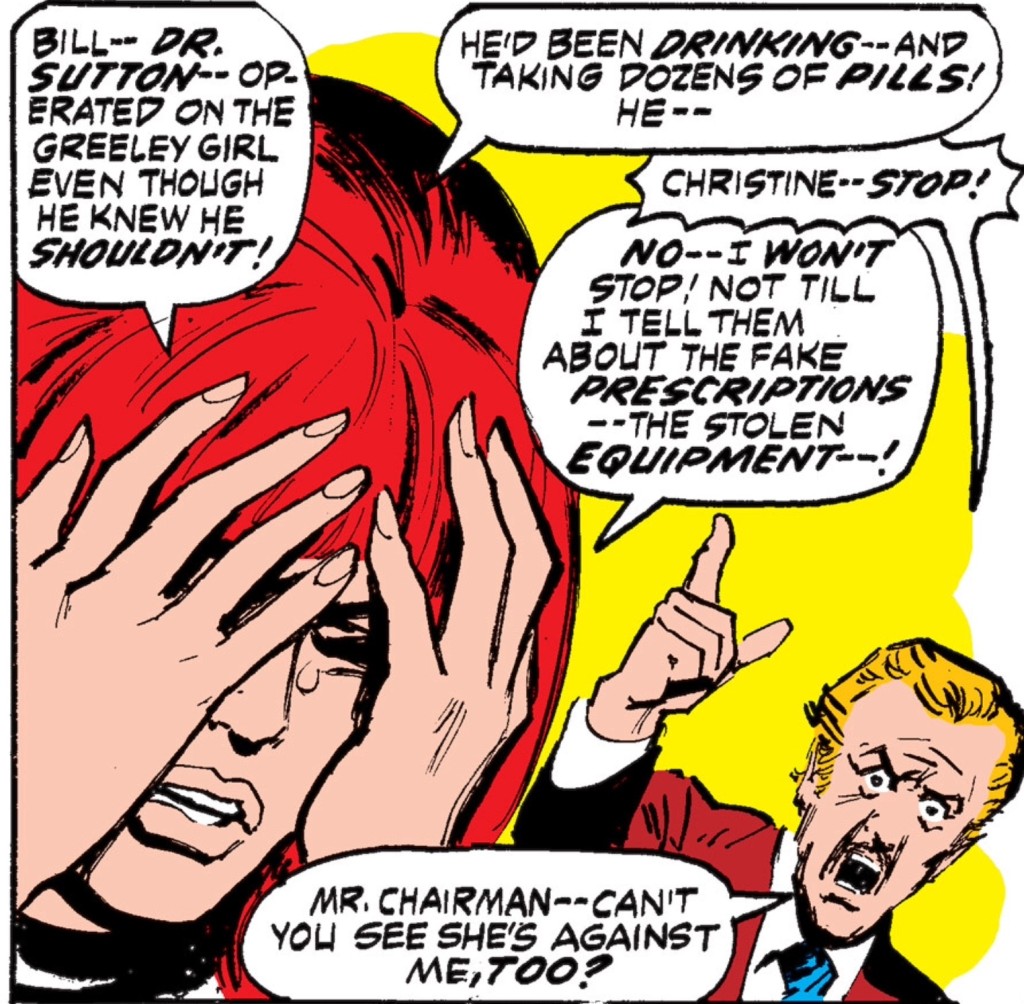
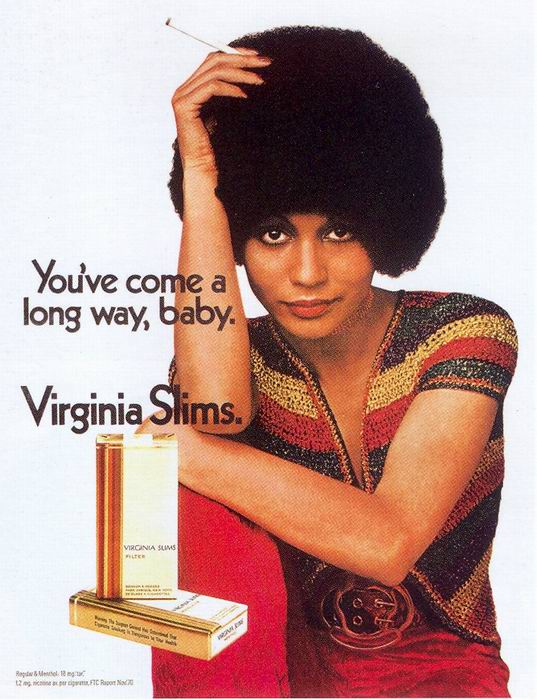


Really liked the analysis here. I want to say that it makes TCJ look like Newsarama, or The Beat look like Bleeding Cool, or the Encyclopedia Britannica look like a bag of anesthesized housecats, but that’s because I’m a jerk. Working on that.
The paragraph above the cover shot of #2 is great, but what I love most is that I’m dead sure you did the research to justify the “middle-aged men with mustaches” line about Win Mortimer. That’s commitment …
Wow Jeff! How timely! This is just in time for people to order the bargain priced (only $7.99!) reprint of Night Nursel that Marvel ahs coming out in May. Seriously! It even has an issue of Bendis’ Daredevil.
http://www.comicbookresources.com/?page=article&id=59364